From catching a cool breeze on a sunny day to zipping along bustling city streets, electric skateboarding has swept the world with its both its fun and convenience. But, like any high-tech toy, it demands a certain level of upkeep. In this comprehensive guide, we’ll delve deep into the world of electric skateboard wheel maintenance — illuminating the essentials, demonstrating how to prolong battery life, and shedding light on every cog in the intricate machinery of your E-Skateboard.
What we’ll cover:
- E-Skateboard Wheel Basics
- Key Wheel Care Factors
- Battery Life Preservation
- Bearings Role in Wheel Maintenance
- Wheel Rotation & Balancing
- Bearings Cleaning & Lubrication Guide
- Regular Axle Checkups
- Belt and Gear Maintenance
- Dealing with Rust
- Fine-Tuning Your Skateboard
Ready to roll? Let’s dive in and discover why wheel maintenance is the secret to an unforgettable, unending electric skateboarding adventure!
Understanding the Basics of Electric Skateboard Wheels
Electric skateboards are growing in popularity, and with that comes the necessity to learn about their maintenance, especially when it comes to skateboard wheels. The wheels of an electric skateboard are its connection to the ground, ensuring smooth movement while absorbing the shocks and bumps of the road.
The basic anatomy of wheels consists of four primary components: the core, the lip, the contact patch, and the durometer. The core is the center part of the wheel where the bearings fit in. The lip refers to the edge of the wheel, which can be rounded or square, impacting how much grip the wheel has. The contact patch is the part of the wheel that touches the ground, determining grip and slide characteristics. Lastly, the durometer measures the wheel’s hardness, affecting its grip and slide properties.
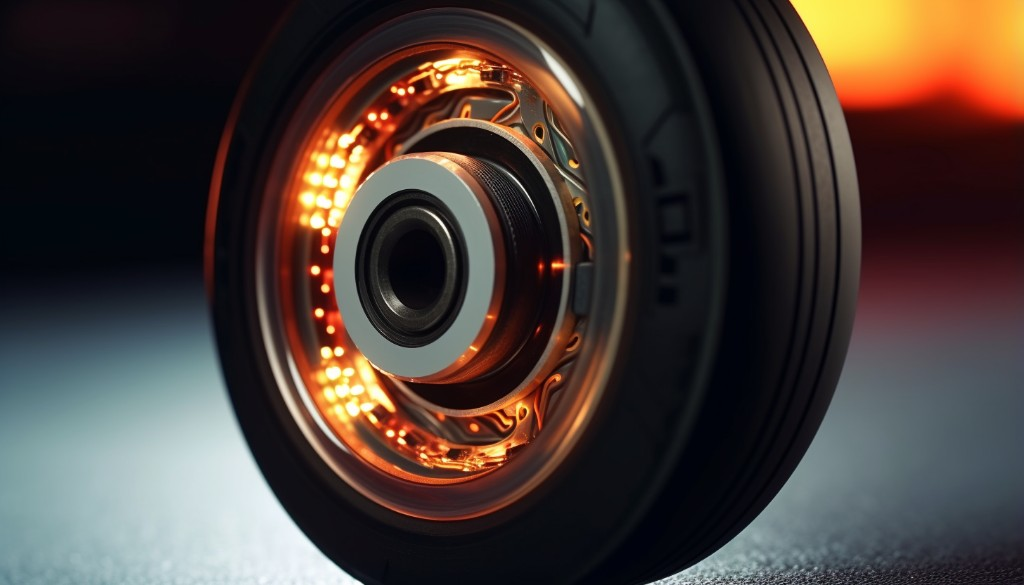
Materials used in making these wheels usually include urethane or rubber. Urethane wheels are more common and offer benefits like good grip, durability, and a wide range of hardness options. Rubber wheels, on the other hand, provide superior shock absorption but tend to wear out quicker.
Understanding skateboard wheel maintenance is crucial as it directly impacts the performance of your electric skateboard and its lifespan. Regular maintenance will ensure that your ride remains smooth and safe.
Vital Factors in E-Skateboard Wheel Care
When it comes to electric skateboard wheel care, there are several key factors to consider. One of them is assessing wear and tear. Regularly checking your wheels for signs of damage like cuts, flat spots, or chunks missing is essential. If you notice excessive wear tear on your wheels, it may be time to replace them.
Creating a maintenance schedule can also aid in skateboard maintenance. This could be weekly, monthly, or quarterly, depending on how frequently you ride your skateboard. Regular inspections will help catch issues early before they become major problems.
Another important factor is understanding how your riding conditions impact your skateboard wheels. For instance, riding on rough surfaces can cause much faster wear than smooth pavement. Similarly, performing lots of slides or high-speed downhill runs will put extra stress on your wheels and cause them to wear out sooner. Therefore, adjusting your riding style or even choosing different wheels more suited to your specific conditions can greatly extend their lifespan.
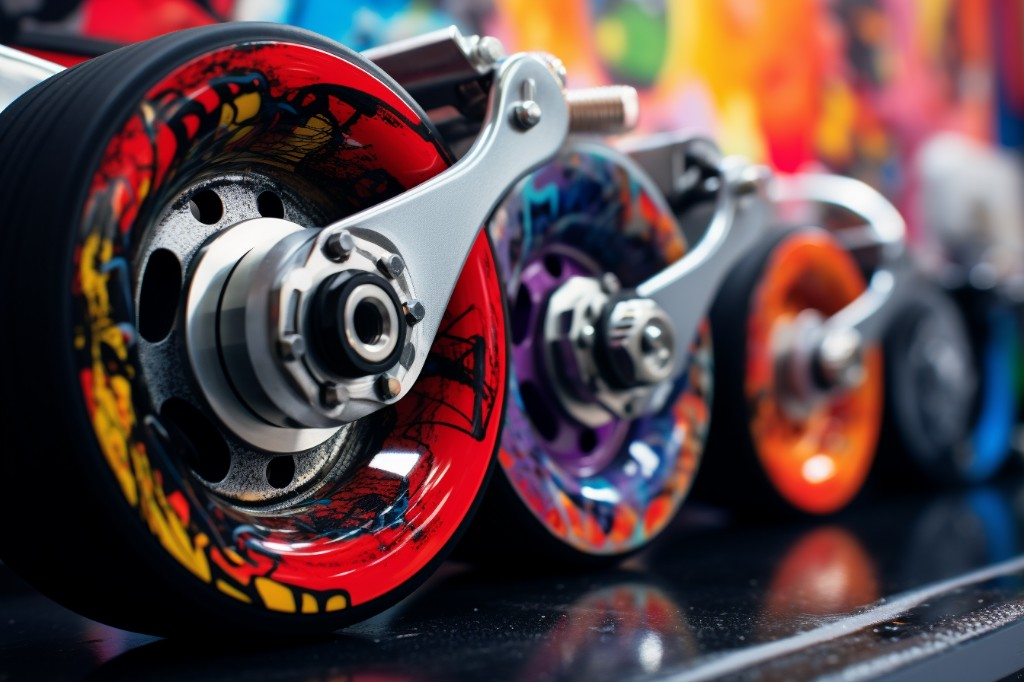
Maintaining Electric Skateboard Battery Life
While taking care of your electric skateboard wheels is crucial, it’s equally important not to neglect your skateboard battery life as well. The battery is what powers your board and allows for that thrilling ride.
Proper battery care is essential to keep your electric skateboard running optimally. One tip to extend battery life is always to fully charge the battery before using it and avoiding depleting it completely before recharging. This helps to preserve the health of the battery and extend its lifespan.
Another important thing is to avoid exposing your electric skateboard battery to extreme temperatures as these can adversely affect its performance and lifespan. Always try to store and use your board at room temperature whenever possible.
Knowing when to replace batteries is also part of good skateboard maintenance. If you notice that your battery isn’t holding a charge as long as it used to or if it’s swelling or leaking, it’s time for a replacement.
In a nutshell, maintaining your electric skateboard involves taking good care of both its wheels and battery. With proper care, you can enjoy many thrilling rides on your skateboard while ensuring it remains in top condition.

The Role of Bearings in Electric Skateboard Wheel Maintenance
Bearings play a pivotal role in the smooth operation of your electric skateboard. They are responsible for reducing friction between the wheels and the axle, enabling the wheels to spin freely. When it comes to skateboard bearings, there are some primary types to consider.
The most commonly used in electric skateboards is the ball bearing. This kind involves a set of steel balls enclosed in a metal ring known as the race. These balls act as a buffer between the moving parts of the skateboard, resulting in smoother wheel rotation.
Another type you may come across is the plain bearing, also known as a sleeve or journal bearing. Unlike ball bearings, they don’t have any rolling elements. Instead, they use a layer of lubricant to reduce friction between the moving surfaces.
For efficient electric skateboard maintenance, bearing inspection is essential. This process is centered on checking for signs of wear and tear, ensuring they remain well-lubricated, and replacing them when necessary. Regular bearing mechanical checks can significantly extend the lifespan of your electric skateboard, ensuring it stays in top shape for longer.
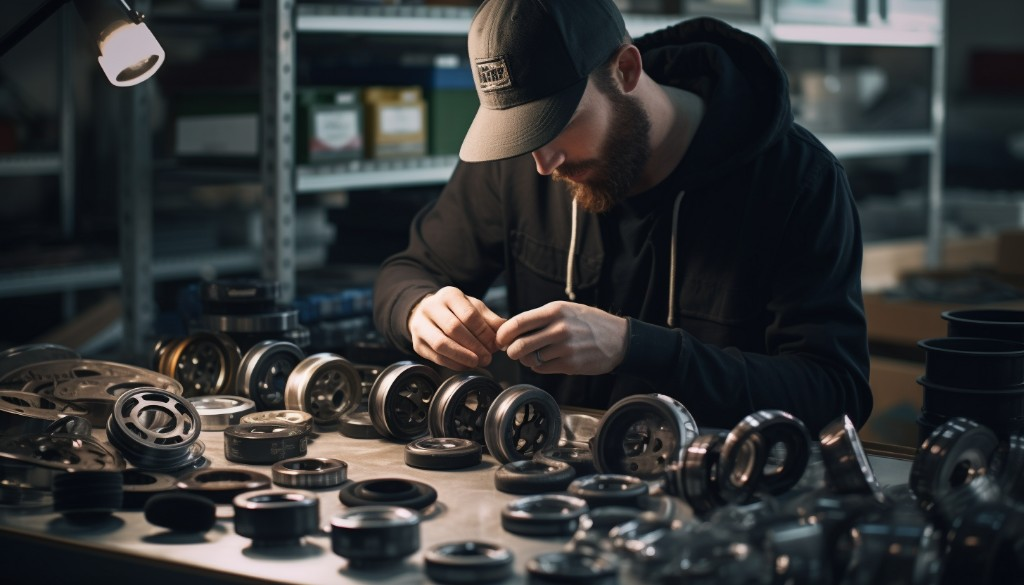
Regular Wheel Rotation & Balancing for Better Performance
Just like your car wheels need rotating to ensure even wear, so too do your skateboard wheels. Regular wheel rotation is an essential aspect of skateboard maintenance that often goes overlooked.
Rotating your wheels involves swapping the front and back wheels or switching the left and right ones. The aim is to ensure that all your wheels wear down evenly, which can prolong their lifespan and save you some money in the long run.
Balancing your wheels is equally critical for optimal skateboard performance. Unbalanced wheels could lead to unstable rides, which not only affects your performance but can also be potentially dangerous.
Here’s a step-by-step guide on how to balance your wheels:
- Remove the wheels from your skateboard.
- Clean them thoroughly.
- Use a wheel balancer to check if the wheels are balanced. If they are not, add balance weights until they are.
- Reattach the balanced wheels to your skateboard.
Remember that taking care of your wheels and bearings is key to maintaining good skateboard performance.

Cleaning and Lubricating the Bearings: A Step-by-Step Guide
Bearings are one of those components that often get neglected when it comes to cleaning an electric skateboard. But did you know that dirty bearings could slow down your electric skateboard?
Here’s why you need to clean the bearings regularly:
- Dirt and grime can increase friction between the moving parts of the bearing, slowing them down.
- If left unchecked, dirt can cause bearings to wear out faster.
- Cleaning extends the lifespan of your bearings and therefore, your skateboard.
To keep your bearings in top shape, follow these steps:
- Remove the bearings from your skateboard.
- Clean them using a degreaser or cleaning solution designed specifically for bearings.
- Once cleaned, dry them thoroughly using a clean towel or air dry them.
- Apply lubricant inside the bearings to reduce friction and prevent rusting.
How often should this be done? Well, if you ride your electric skateboard regularly, cleaning and lubricating the bearings once every two months should suffice. However, if you ride in wet or dirty conditions frequently, you may need to clean and lubricate more often.
By understanding how to properly clean and lubricate the bearings, you can help ensure smooth rides and prolong the lifespan of your electric skateboard.

The Importance of Regular Axle Inspections
An electric skateboard is only as good as its parts, and one component that plays a pivotal role is the axle. This metal rod holds the wheels in place and is responsible for ensuring smooth and stable movement. Without it, you’d be skating on thin air! Therefore, regular axle inspection is a must.
To carry out an axle inspection, you’ll need to remove the wheels. Take off the nuts at the end of the axle and slide off the wheels. Be sure to keep all components in a safe place for reassembly. Once the wheels are off, inspect the axle for any signs of wear or damage. Look for bends, chips, or rust. A shiny, straight axle is what you want to see. If it looks anything other than that, consider replacing it.
Also, don’t forget to check the screws that hold the axle to the skateboard. Loose screws can lead to wobbly rides and, in the worst-case scenario, can cause your wheels to come off mid-ride! So, always ensure that you give those screws a good tightening during your inspection. The simple act of making sure the screws are secure can save you from potential accidents.

Taking Care of Your Electric Skateboard’s Belt and Gear
Last but certainly not least, let’s talk about your skateboard’s belt mechanical and gear system. These two parts are key players in propelling your skateboard forward (or backward if you prefer!) on your all-important wheels.
The tension in your belt mechanical system plays a big part in how smoothly your skateboard rides. Too loose and you may have slippage or reduced speed; too tight and you might strain your motor or wear out your belt faster.
Maintaining your gear system involves regular cleaning and lubrication. Remove any grime or dirt buildup and use a small brush to apply some lubricant. This will keep everything running smoothly and extend the life of your gears.
Belts electric systems also need regular checks, just like the traditional belt mechanical systems. Be sure to inspect them regularly for signs of wear or damage. Over time, belts can become frayed or might even break entirely.
It’s always a good idea to keep a spare belt gear handy in case you need to replace yours unexpectedly. Replacing a belt gear isn’t too complicated – it’s similar to changing a bike chain if you’ve ever done that. But remember: proper maintenance can prolong their lifespan significantly.
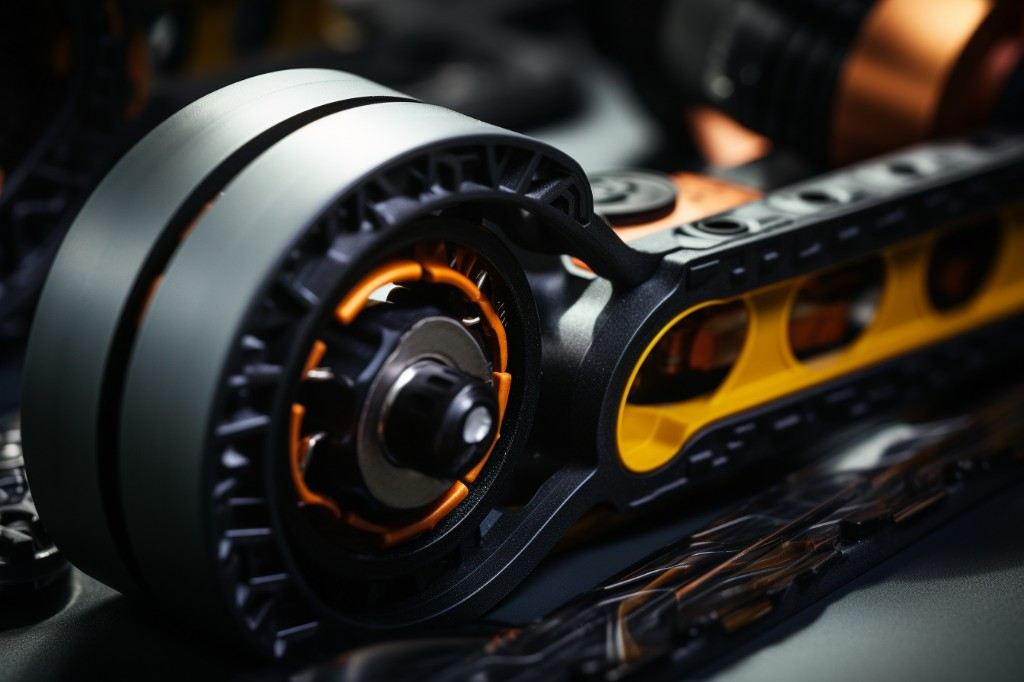
Dealing with Rust: Prevention & Treatment Strategies
Rust is a major enemy of most metal parts, including those of your electric skateboard. This corrosion process is mainly caused by a combined exposure to air and moisture, or in other words, oxygen and water. Salt, either from the sea air or winter road treatments, can also accelerate rusting. Hence, it’s imperative to consider various rust prevention strategies for your electric skateboard’s wheels.
One effective strategy for rust prevention involves regular cleaning and drying of your skateboard, especially after it’s been used in a wet or salty environment. Also, storing it in dry conditions can significantly reduce the chances of rust formation. If possible, keep your electric skateboard indoors or under cover when not in use to protect it from the elements.
Another useful tip is to apply anti-rust coatings or spray-on lubricants on the wheels and other metal parts. These products form a protective barrier that keeps air and water away from the surface of the metal, inhibiting rust development.
Treatment for rusted parts typically involves removal of the rust and re-protection of the metal. Minor rust spots can usually be dealt with by cleaning the part with a wire brush or sandpaper to strip away the corrosion. More serious rusting might require you to replace the part altogether.
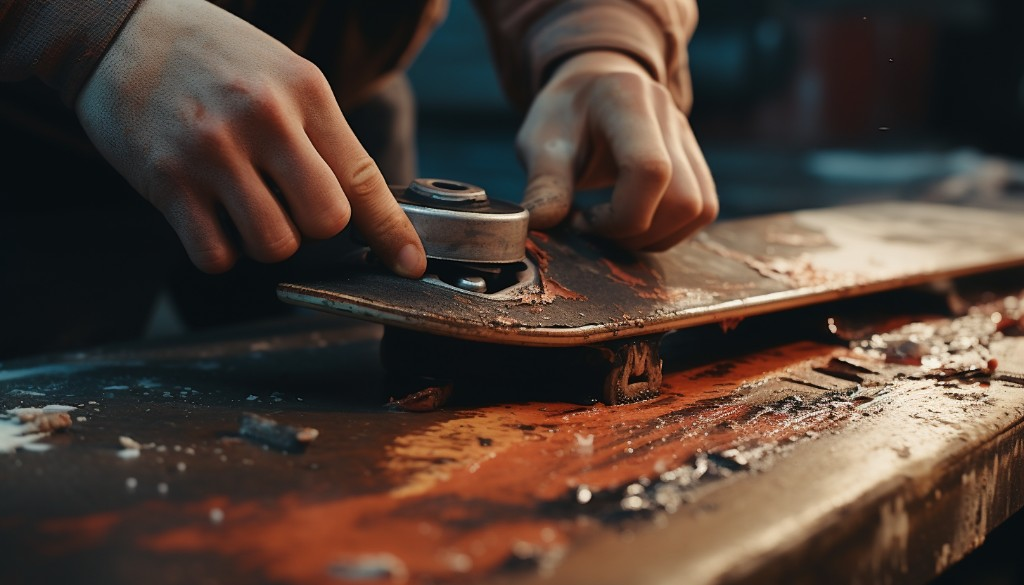
Fine-Tuning Your Skateboard for Enhanced Durability & Lifespan
When it comes to electric skateboard maintenance, regular check-ups and tune-ups are key. A well-maintained skateboard not only rides better but also lasts longer, enhancing both its durability and lifespan.
Routine inspection should be part of your electric skateboard maintenance plan. Look for any signs of wear and tear, especially on the wheels and bearings. Cleaning these components regularly can help them perform at their best and also extend their life.
Ensuring proper alignment of parts is another important aspect of electric skateboard maintenance. Misaligned wheels, for instance, can cause uneven wear and potentially reduce the board’s performance and lifespan. So, always make sure that your wheels are properly aligned and tightly secured.
Maintenance costs might seem a hassle initially, but they’re definitely worth it in the long run. Regular upkeep helps prevent major issues down the line that could be more costly to fix and could potentially shorten your skateboard’s lifespan.
Closing Thoughts
In conclusion, understanding the basics of electric skateboard wheels is crucial to their maintenance. It’s necessary to consider various factors such as regular wheel rotation and balancing, which contribute to better performance. The role of bearings in electric skateboard wheel maintenance is significant, and they require regular cleaning and lubrication. Frequent axle inspections are equally critical in averting potential damages. Carrying out regular maintenance on your electric skateboard will ensure you spot any minor issues before they become more complex and troublesome. This will undoubtedly help to prolong the lifespan and performance of your beloved board.
Frequently Asked Questions
What are the essential tools needed for electric skateboard wheel maintenance?
For effective electric skateboard wheel maintenance, there are several tools one must have, including cleaning solutions, lubricants, a bearing puller, screwdrivers, and a wrench. These will help in tasks such as disassembling parts for cleaning, lubricating bearings, or tightening loose components.
How often should I clean and lubricate my skateboard’s bearings?
Generally, it’s advisable to clean and lubricate your skateboard’s bearings every 3-4 weeks or after about 50 hours of riding time. However, this duration may vary based on factors such as the type of terrain you usually ride on, the weather conditions, and how frequently you use your electric skateboard.
What are some signs that my electric skateboard’s battery needs replacement?
Signs that your electric skateboard’s battery needs replacement include a significant reduction in run time, slow charging, or if the battery gets unusually hot during use or charging. Other indicators could be a swelling battery pack or if the skateboard’s speed and performance decline noticeably.
Is it necessary to rotate and balance my electric skateboard’s wheels regularly?
Yes, it is necessary to regularly rotate and balance your electric skateboard’s wheels. Regular rotation prevents uneven wear and tear, extending the wheels’ lifespan. Balancing, on the other hand, enhances stability and smoothness during rides.
How can I prevent rusting on my electric skateboard?
To prevent rusting on your electric skateboard, minimize its exposure to moisture as much as possible. After riding in wet conditions, dry off the skateboard thoroughly. Regularly cleaning and oiling the skateboard’s metallic parts can also help to prevent rust.
